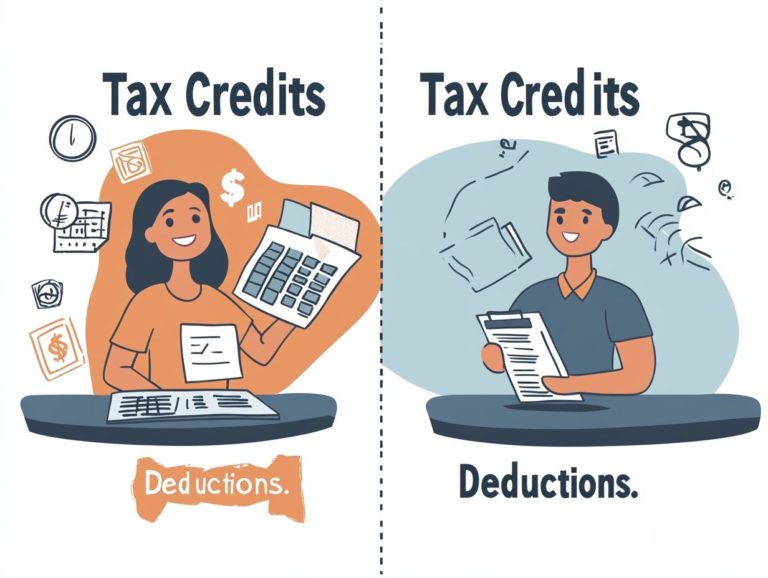What is the Freelancer’s Guide to Maximizing Retirement Savings?
Navigating retirement savings can be challenging for freelancers. They often lack the benefits offered by traditional employment.
It is essential to understand the various options available, such as Traditional and Roth IRAs, Solo 401(k)s, and SEP IRAs, along with other savings plans. This understanding helps build a secure financial future.
This guide is packed with effective strategies to supercharge your retirement savings, highlights important tax considerations, and provides tools to help create a personalized retirement savings plan. It focuses on income management and risk protection.
Whether you are just starting out or looking to enhance your existing strategy, this information will equip you with the knowledge needed to take control of your financial future.
Contents
- Key Takeaways:
- Understanding Retirement Savings Options
- Maximizing Retirement Savings as a Freelancer
- Tax Considerations for Retirement Savings
- Planning for Retirement as a Freelancer
- Frequently Asked Questions
- What is the Freelancer’s Guide to Maximizing Retirement Savings?
- Why is it important for freelancers to maximize their retirement savings?
- What are some strategies for maximizing retirement savings as a freelancer?
- What types of retirement accounts are available for freelancers?
- How can freelancers take advantage of tax benefits when saving for retirement?
- What role do investments play in maximizing retirement savings as a freelancer?
Key Takeaways:
- Start saving now! Every little bit adds up.
- Freelancers can also benefit from tax deductions and credits for retirement savings. Understanding and managing taxes effectively is crucial to maximize savings.
- Create a personalized plan. Assess your goals and needs, and develop a tailored strategy that best fits your situation to maximize your retirement savings and ensure long-term security.
Why Retirement Savings Matter for Freelancers
Retirement savings are crucial for freelancers as they ensure long-term financial stability, particularly since freelancers typically lack access to employer-sponsored retirement plans. Unlike salaried employees, freelancers must actively manage their finances, which includes saving for retirement and employing effective budgeting techniques to meet their financial goals.
Without adequate retirement savings, freelancers may struggle to cover basic expenses during their retirement years. They might have to take on additional work to supplement their income, which can be unpredictable in self-employment. Income gaps and fluctuations in demand are common among freelancers. Therefore, it is essential to build a cash buffer to withstand these variations.
The absence of employer-funded retirement benefits means freelancers must be proactive in developing their own retirement plans through consistent savings and utilizing tax-advantaged accounts such as IRAs or Solo 401(k)s.
Understanding Retirement Savings Options
Freelancers have several options for retirement savings, including Individual Retirement Accounts (IRAs), 401(k)s, and other savings plans. Understanding these options is crucial, as freelancers have various ways to secure their financial future during retirement.
Unlike employees, who typically have retirement plans managed by an employer, freelancers must select from a diverse range of self-employment retirement options and navigate their complexities. Identifying the best investment vehicles for their long-term financial goals, including options for diversification, is essential.
Ready to take control of your retirement? Start planning today!
Traditional vs. Roth IRA
Freelancers should think about Traditional and Roth IRAs for their retirement savings. Both offer unique tax benefits and contribution options.
With a Traditional IRA, you can contribute pre-tax income. This could lower your taxable income for the year.
On the other hand, a Roth IRA allows you to contribute after-tax income. This means your earnings and withdrawals can be tax-free in retirement.
The tax rules for Traditional and Roth IRAs are quite different. Freelancers often deal with tax issues and variable income. A Traditional IRA can provide immediate tax relief since contributions may reduce your total income, potentially lowering your tax bracket for the year.
However, this could lead to a future tax burden if you find yourself in a higher tax bracket later.
On the flip side, Roth IRAs may suit freelancers who expect to earn more in retirement. They allow for tax-free withdrawals, which can lead to substantial savings over time. Roth IRAs have specific eligibility criteria based on income limits, while Traditional IRAs do not have such restrictions.
Your choice really depends on your future income expectations and current financial situation. This involves careful budgeting and managing your cash flow.
Solo 401(k) vs. SEP IRA
Freelancers often face the decision of choosing between a Solo 401(k) and a Simplified Employee Pension (SEP) IRA for their retirement savings. Each option is designed for different financial needs and has distinct contribution limits.
A Solo 401(k) allows for higher contributions since it includes both employee and employer contributions. This is great for those looking to maximize their retirement savings.
In contrast, the SEP IRA offers simpler management and is easy to set up, but it mainly limits contributions to employer contributions.
This article compares the two accounts and highlights key points freelancers should think about when choosing. Assessing your income levels and retirement goals is crucial.
For 2021, a Solo 401(k) permits contributions of up to $58,000, including catch-up contributions for those aged 50 and older. This is also the maximum allowed for a SEP IRA in 2021.
However, the Solo 401(k) is better suited for a wider range of income levels.
Contributions to a Solo 401(k) can include an employee deferral of up to $19,500 for 2021, along with additional employer contributions. This brings the total contributions up to $58,000 for the year.
Keep in mind that 2021 may not reflect typical income levels. For example, an individual earning $45,000 in 2021 would be limited to that amount for their Solo 401(k). This breaks down to $19,500 as employee contributions and $25,500 as employer contributions.
In comparison, the SEP IRA only accepts employer contributions capped at 25% of total income. For someone earning $45,000, the employer contribution would be $11,250, resulting in a total contribution of $58,000—matching the maximum for the SEP IRA.
However, the SEP IRA does not consider employee deferrals.
Additionally, the Solo 401(k) provides extra benefits like the option to take loans and invest in a wider variety of options. Loans are accessible after the first year of contributions, while the SEP IRA lacks this flexibility.
While the Solo 401(k) may require more administration, the SEP IRA is simpler to establish and maintain.
Ultimately, if you want a retirement account that accommodates a diverse range of income levels and investment options, a Solo 401(k) is generally the better choice. By carefully evaluating these factors, freelancers can make informed decisions about which retirement account will best help them achieve their financial goals.
Maximizing Retirement Savings as a Freelancer
Freelancers can maximize their retirement savings through smart financial planning and budgeting. This ensures consistent contributions to their retirement accounts over time. Unlike traditional employees, freelancers do not receive steady paychecks. This means they need a proactive approach to their savings strategies and cash flow management.
By setting clear financial goals and optimizing their time to earn income from various clients, freelancers can build a retirement portfolio that matches their long-term objectives. They should focus on growing and protecting their assets.
Setting Savings Goals
Savings goals are crucial for retirement planning as they align financial handling with retirement aspirations. By figuring out how much they need to save each year and defining specific targets, freelancers can budget effectively, manage expenses, and make informed decisions that ensure their future financial security. Setting achievable savings goals not only motivates freelancers but also fosters a sense of accomplishment as they reach milestones.
To set effective savings goals, freelancers must first understand their retirement needs. This understanding depends on factors like their anticipated standard of living, healthcare costs, and expected sources of income during retirement. Using a retirement calculator can provide a preliminary estimate, while financial advisors can offer tailored solutions.
Once freelancers have their savings goals, they should regularly track their progress and adjust their strategies as needed. Using expense tracking tools and maintaining a disciplined savings habit are vital to staying on track toward their retirement objectives.
Strategies for Increasing Savings
Freelancers can enhance their savings through several effective strategies:
- Diversify income sources to improve contribution levels and protect against income fluctuations.
- Leverage technology to automate contributions to savings accounts or retirement funds.
- Review and adjust expenses regularly to identify unnecessary costs that can be redirected toward savings.
Diversifying income helps freelancers explore side jobs, passive income opportunities, or collaborative projects to expand their earnings. Automating contributions simplifies the process and helps ensure money is set aside without temptation. Regularly reviewing expenses allows freelancers to redirect funds toward their savings.
Tax Considerations for Retirement Savings
Tax considerations for retirement savings are especially important for freelancers. Tax implications can significantly influence their financial strategy and net earnings. Unlike traditional employees, freelancers bear the full burden of taxes but can deduct retirement contributions from their taxable income, lowering their tax liability.
By taking advantage of tax credits and understanding IRS regulations and limits for retirement accounts, freelancers can enhance their retirement savings while minimizing tax exposure. This is a great benefit of their self-employment status.
Don’t miss out on planning for your future! Start implementing these strategies to build your retirement savings today.
Tax Deductions and Credits for Freelancers
Freelancers can access many tax deductions and credits. These can greatly affect their retirement savings, so staying informed about IRS regulations is essential.
Eligible contributions to retirement accounts, such as IRAs and 401(k)s, are often considered expenses that lower your taxable income. This helps reduce freelancers’ overall taxable income.
Additional tax credits can support savings efforts. They allow for higher contributions to these accounts and enhance retirement security. By understanding these factors, self-employed individuals can better plan their finances.
For instance, the Self-Employed Retirement Plan, known as SERP, enables freelancers to save 20% of their income. Contribution limits often exceed those of traditional retirement accounts. The Saver’s Credit is another valuable benefit for individuals within certain income brackets, offering a percentage of their contributions back as a credit.
Together, these measures provide freelancers with a solid framework to meet their short-term financial needs while building a foundation for long-term wealth and stability. This ultimately ensures a comfortable retirement.
Managing Taxes in Retirement
Managing taxes in retirement is crucial for freelancers. Understanding how retirement income is taxed can significantly impact their financial situation.
Freelancers need to implement effective tax strategies to navigate the taxation of retirement income. This allows them to maximize their benefits while minimizing liabilities. A well-structured tax plan will help protect their savings and ensure they can maintain their lifestyle during the transition into retirement.
Freelancers can employ several strategies to better manage taxes in retirement:
- Withdrawal Strategy: It is important to be cautious about how withdrawals are made from retirement accounts. Different accounts come with varying tax implications. For instance, distributions from a Roth IRA are generally tax-free, while traditional IRAs require taxes to be paid at the time of withdrawal. This could push retirees into a higher tax bracket.
- Income Diversification: Retirees should consider part-time work or investments that provide a more balanced income profile. This can also lead to a more balanced tax profile.
- Tax Deductions: Being aware of available tax deductions for retirees, such as those for certain healthcare or charitable expenses, can enhance tax efficiency.
Planning for Retirement as a Freelancer
Retirement planning for freelancers involves understanding the various savings plans and investment options available. To find the best fit, freelancers must explore various retirement accounts and make smart savings choices.
They should consistently set aside money and collaborate with financial advisors who can offer professional guidance. Freelancers can also use retirement calculators to project their future needs. This can help determine whether they are on track to meet their retirement goals, enhancing their financial management.
Retirement Savings Calculators and Tools
Retirement savings calculators and tools are invaluable resources for freelancers looking to plan for the future. These tools can provide realistic projections and facilitate goal setting.
By allowing users to input personal data regarding income, desired retirement age, and goals, they offer tailored recommendations on how much to save and invest over time. With this information, freelancers can make more informed decisions about retirement accounts and contribution levels.
Many of these calculators feature scenario analysis, enabling users to explore how different saving strategies or changes in income could impact their retirement savings trajectory. Additionally, some tools work together with investment platforms, simplifying portfolio management.
User-friendly designs and mobile compatibility make it easy for freelancers to incorporate these resources into their busy lives. This allows for more frequent reviews of their plans. By utilizing these comprehensive tools, individuals can not only visualize their retirement journey but also adapt their strategies as their circumstances evolve.
Don’t wait! Start planning your retirement today to secure your financial future!
Creating a Retirement Savings Plan
Establishing a retirement savings plan is the first and most crucial step for freelancers to create a solid foundation for their retirement strategy. This plan outlines specific actions that freelancers need to take, including how much to save each month and which retirement accounts best suit their individual circumstances. A well-structured retirement savings plan is vital as it helps prevent issues such as overextending savings at the expense of their current lifestyle or underestimating savings, leaving them unprepared for retirement.
When creating their retirement savings plan, freelancers should focus on several key components, including budgeting and risk management:
- Setting Retirement Goals
Freelancers should begin by identifying their desired retirement lifestyle and estimating how long they intend to work before retiring. This helps identify retirement goals and how much money is needed, considering their health insurance needs. - Estimating Income and Future Earnings
It is essential to realistically assess current and future income from freelancing work. Future earnings can be projected based on historical trends or by evaluating market conditions in their specific field alongside contracts. - Creating a Budget
Creating a budget is exciting! It lets freelancers see exactly how much they can save and spend. A well-developed budget ensures that funds are consistently allocated for retirement savings, aligning with their goals and providing flexibility in their financial planning. - Choosing a Retirement Savings Account
Freelancers should evaluate accounts like IRAs (Individual Retirement Accounts) or Solo 401(k)s, which are retirement savings plans designed for self-employed individuals. These accounts help them understand the tax implications of their retirement savings, facilitate fund growth, and can be tailored to meet their specific needs, especially regarding tax deductions.
Frequently Asked Questions
What is the Freelancer’s Guide to Maximizing Retirement Savings?
The Freelancer’s Guide to Maximizing Retirement Savings is a valuable resource for freelancers and independent contractors. It offers practical tips and tools to help you effectively save for retirement.
Why is it important for freelancers to maximize their retirement savings?
As a freelancer, you lack an employer-sponsored retirement plan. Taking charge of your retirement savings is essential for building a secure financial future.
What are some strategies for maximizing retirement savings as a freelancer?
Strategies include setting up a retirement account and contributing regularly. Don’t forget to take advantage of tax benefits and make smart investment choices that fit your goals!
What types of retirement accounts are available for freelancers?
Freelancers can choose from Traditional and Roth IRAs, Simplified Employee Pension (SEP) IRAs, and Solo 401(k)s. Each type has different eligibility rules and contribution limits.
How can freelancers take advantage of tax benefits when saving for retirement?
You can lower your taxable income by contributing to retirement accounts like IRAs and 401(k)s. This not only helps you save more for retirement but can also reduce your tax bill!
What role do investments play in maximizing retirement savings as a freelancer?
Investments are vital for growing your retirement savings over time. By diversifying your portfolio, you can manage risks and protect your assets while aiming for higher returns.










